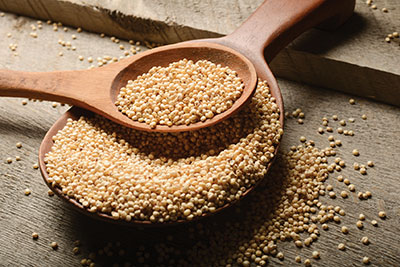
The Final Proof: October 2014
September 15, 2014
By Jane Dummer RD
While sorghum is one of the world’s most familiar foods, it is largely unexplored in North America.
While sorghum is one of the world’s most familiar foods, it is largely unexplored in North America.
 |
|
| Sorghum is the dietary staple of more than 500 million people in more than 30 countries.
|
Is sorghum the next ancient grain to take on the baking industry? I’ve been writing about quinoa, amaranth, millet, chia and hemp, but I was unaware of sorghum’s potential until this past summer at IFT 2014 in New Orleans when I was invited to a superb education and culinary event called Sorghum 360.
The event’s showstopper was a demonstration lunch with Iron Chef Marc Forgione. It was a creative, delicious display of how sorghum can be used in different applications. From easily popping the whole grain to add crunch to his first course of scallop ceviche, to using sorghum flour for a green (spinach) air bread bed for his main course of strip steak and escargot, Chef Forgione was passionate about the versatility of sorghum. His enthusiasm was contagious and now I’m experimenting with sorghum in my home kitchen.
Sorghum is gluten-free and has a fairly neutral flavour and colour. The whole grain is small, so it behaves similar to a seed such as quinoa (with less fat). According to Earl Roemer, President of Nu Life Market in Scott City, Kansas, “Sorghum flour is utilized as the primary ingredient in gluten-free flat breads, pizza crusts, muffins, cookies, pancakes, waffles, brownies, cakes, and risen breads. It is readily available both in retail and bulk packaging. Without gluten, bakers often incorporate a binder such as xanthan gum or cornstarch to add “stretch.” Gluten-free flour blend mixes with sorghum are becoming more popular. Besides being gluten-free, this ancient grain is non-GMO and has an excellent nutrition profile, therefore, we have seen the consumer demand increasing at very fast pace.”
Sorghum may be the new ancient grain for Canada and the U.S., but it is the dietary staple of more than 500 million people in more than 30 countries of the semi-arid tropics, making it one of the most familiar foods in the world.
Doug Bice, Program Director High Value Markets of the United Sorghum Checkoff Program, explains: “Sorghum is indeed an ancient grain. There are reports on sorghum remains found in the Nabta Playa archaeological site in the Western Desert, in southern Egypt, dating back to 8000 B.C.E. Today, worldwide, only four other foods (rice, wheat, maize, and potatoes) are consumed in greater amounts.” He says sorghum is among the most efficient crops in conversion of solar energy and use of water, which makes it very sustainable.”
As for sorghum’s nutritional profile, this whole grain does not contain the protein needed for gluten production and it has half the fat when compared by quantity to amaranth and quinoa. This gives it a drier and slightly chewier texture. Sorghum is considered a complex carbohydrate and a source of dietary fibre. Depending on the variety, sorghum provides phytochemicals which can promote heart and brain health. At IFT 2014, Dr. Nancy Turner, an associate professor at Texas A&M University, talked about sorghum’s digestive health properties – including the ability to increase satiety and the potential to reduce the risk of colon cancer.
With the growing interest in sorghum, it’s now finding a place on our menus. The Sorghum 360 event gave me the opportunity to try Chef Forgione’s delicious sorghum air bread. It was fun to eat with its light and springy texture and its bright green colour from the spinach. The flavour from the garlic was an excellent savory combination with the mild sweet of the sorghum flour.
“I particularly like to use the air bread with main entrées so it can soak up the sauce and/or butter. It acts just like a sponge,” says Chef Forgione. “It was perfect to use as a bed for the main course of steak and escargot. Which begs the question, in addition to being creative with sorghum flour in the baking industry, why not be innovative with bread to replace the typical bed of rice, pasta or couscous in the traditional main dish?”
I’m eager to try that myself, as I’m still experimenting with the flour in my home kitchen. However, I’m not going to explore any molecular gastronomy techniques. I’ll leave that up to Iron Chef Marc Forgione!
Jane Dummer, RD, is a leading dietitian for the Canadian food and nutrition industry. Jane offers services specializing in agri-food, functional foods and food safety. For more information, please visit www.janedummer.com
Print this page
Leave a Reply